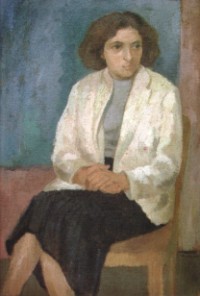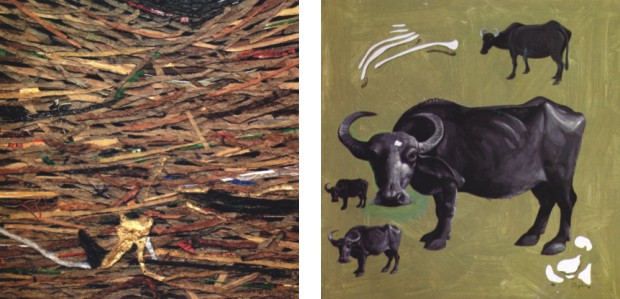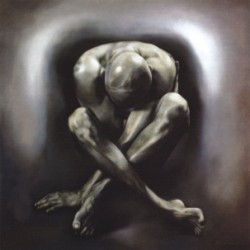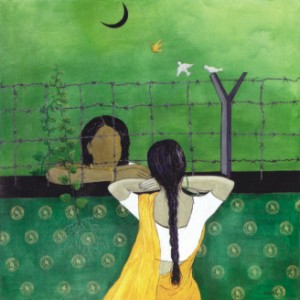| Home - Back Issues - The Team - Contact Us |
 |
| Volume 10 |Issue 15 | April 16, 2011 | |
|
|
Art Brilliance on Canvas Fayza Huq
To wrap up the ten marathon efforts, presenting Bangladeshi fine arts, at Bengal Gallery, the farewell piece that said” Fin” to the marathon venture–stretching over a year – was the production that ends on April 14. This comprising of young, but highly promising artists,–having won acclaim both at home and overseas–was dominated by the maestro Aminul Islam. The master painter Aminul Islam was followed in the pageant by AS Mustafa, Kazi Syed Ahmed, Shulekha Chowduhury, Sarkar Nahid Niazi, Syed Zahid Iqbal, Md Safin Omar, Sahid Kazi, Bishwjit Goswami and MM Maizuddin. Most of the artists,like Bishawjit Goswami,have won coveted local and overseas awards, like The Elizabeth Foundation Award, Canada; Best Award, Annual Art Exhibition, Institute of Fine Arts Oil Painting (2004, 2005)Sarkar. Nahid Niazi has won the Royal Overseas League Travel Scholarship, UK (2000). Meanwhile Md Safin Ahmed has bagged the Best Award in Painting, 14th Young Artists Art Exhibition, Bangladesh Shilpakala Academy (2002). The members of the triumvirate of the Bangladeshi art world, Zainul Abedin, Quamrul Islam, and Safiuddin Ahmed, had studied in Europe, (apart from Kolkata), followed the footsteps of the doyen of fine arts–Rabindranath Tagor. They carried over the seeds of miraculous visual art to Dhaka, Bagaladesh. Aminul Islam, who heads “Rooted Creativity -10”, was one of the first batch of students, who sat at their feet of three giants of visual art, and gathered wisdom. Like his three teachers, Islam sailed on to Europe, and studied abstraction– for better or worse. He learnt to translate figures, objects and incidents into tangible forms that looked westwards. Under Zainul Abedin's eagle eyes, Aminul Islam experimented with geometrical lines and broken forms – abstraction, as we know it. He continued to dwell on shapes and forms – ; all things made by man and nature, like leaves of grass, branches of bare trees and ceramic objects, like vases and other elements of “still life”. Everything was in proportion, the play of light and shade, the contrast of darkness and sunshine and the muted heavy colours, juxtaposed with pastel ones. Islam's preoccupation with black straight and twisted lines is remarkable, His fixation for lines– of all shapes and sizes – reach out beyond eternity. The magical lines overwhelm one with their drama and mystery. These lines wave and dance with a rhythm of their own. They remain mysterious and miraculous– with magic moments of their own. Their shapes and rhythms are unique. Aminul is a past master in oil, water-colour and lithograph. A prince of portraiture, his women figures are admirable. It's not easy to excel in both realism and abstraction; But Islam does.
In Islam's “Oriental” we see a lady with brown, waving bobbed hair. Her white short, jacket – with folded cuffs, handkerchief from the open breast pocket – is set off by a pale gray, rounded -necked sweater. This in turn, is completed by –the knee length pleated black skirt. She sits on a wooden chair. Meanwhile the walls in the background at the back are gray –green and pale brown. The lithograph by Islam, “Face” has a gorgeous, eastern female form, with chiselled features and perfect limbs and bosoms – complete with “choli”, bangles, with curling and twisting branches at the back. The black and white creation is breathtaking. The “Study” in water-colour, done in 1949, brings in a Hindu ironmonger's shop, with shaven headed workers, complete with round, metal, spectacles, moustache and “tiki” on the head, shown working their hearts out. Meanwhile, the client with a traditionally black umbrella and “gamcha” looks on. Islam's “Landscape”. Done fairly recently, in 2005, brings in a gold and blue landscape. This has waving gold crops, swinging lyrically. The blue sky is an amazing creation, with the sky bearing clouds – which appear like some giant hovering birds of peace.
The other young nine artists are decades younger than Aminul. The gap is there to depict the departure from traditions to express different styles and themes. These artists too are preoccupied with depiction of the human form, with the urban city scenes in the backdrop, They deal with the vain bourgeois. They search for an identity and present the difficulties of urban existence. In the backdrop is the pell-mell growth of buildings, and the rampant destruction of hapless nature. The yearning for peace and contentment goes on. The experimenting painters, of “Rooted Creativity -10”, are more than aware of the loss of innocence, and the change in the sense of values. The nine artists bring in a number of subjects and styles in the representation of their themes. Their ideas use styles that range from the abstract creations to a mind – boggling kaleidoscope of subjects. The mixed media work by Sahid Kazi captures the quixotic element of the existing society around us. His mixed media on canvas brings in the “Monalisa Smile” brings in a lady with a pistol in one hand a glove in the other. The wall at the back is covered with cuttings of newspapers and is pale yellow with age. These contain posters and framed photographs of local political leaders. The two leaders of the country, and ambassadors receiving the usual line up of dignitaries are seen here. The second one depicts the typical smile of the two leaders Hasina and Begum Zia. They are shown greeting each other. Kazi's other painting has squinting and smiling woman, with loose hair, sitting nude, and apparently playing with a tabby kitten. Besides her is a naked male, bearing a knife, with an evil scowl on his face. “Social Life” is mixed media in browns and greys. Sulekha Chaudhury's romantic figures of women are seen against backdrops of saplings and other plants, with their roots included. Tiny maps of Bangladesh are set in the green background – cracked with the heat. This is seen in “Shimanto - I” The older woman, with flowing cascade of hair – the conventional aspiration of Bangladesh women”– is depicted with a swirl of a light green sari; she is looking up at two pieces of red watermelon, with a bird hanging on and pecking at it. Meanwhile, the evil element in the idyllic landscape, contains an invading snake, baring a white water-lily. The other figures in the other canvases, similarly, contain minimised images, with friendship between women in mind. Safin Omar's buffalos, in acrylic on canvases, bring in the domestic horned animal, with the glossy velvety black. They are in different shapes and sizes, colours. The positioning of the animals are as if they are floating in space. Kazi Sayed Ahmed's “Reconstructions”, done in acrylic on sack material, is a post-modern depiction of the existence of man. The sacking is in shades of brown with large, rough stitches.
ASM Mustafa Jamil Akbar's acrylic creations,”Searching Lights”, done in dramatic reds, blacks browns, blues, bring in abstraction, with tiny yellow flecks treats his subjects as if they ware disassociated and in some wild abstract mass. Although MM Maizuddin's “Reality” series is similarly abstract, the treatment is different. Splashes of black and grey bring the buffalo and horse image complete with moving hooves and horns. The staring eyes, done in details, match the elegant mouths. A guard dong with swishing tail is included in the composition, The compositions are dark grey upon slight grey and give the impression of some frieze or cave drawing of the past. The powerful oil on canvas by Bishwajit Goswami are done in startling gray, black, white, brown and grey. They present a nude male figure, seen in deep meditation and prayers. The motifs and geometrical shapes and arrangement of halos vary. They present the quest for peace and contentment by all mankind. Sarkar Nahid Niazi's “Wood Compositions” present wood and board creations. These are in different shades of browns, gray and black. They appear like some marching planks of wood, symbolising life. The neat creations are indeed startling and unique. They are soothing to see, with an element of lyricism of its own. The young artist in “Rooted Creativity-10” presented and fit finale to the parade of painters. Their work depicted boundless energy, fascinating imaginative power and admirable tenacity.
Copyright
(R) thedailystar.net 2011 |
||||||||||



